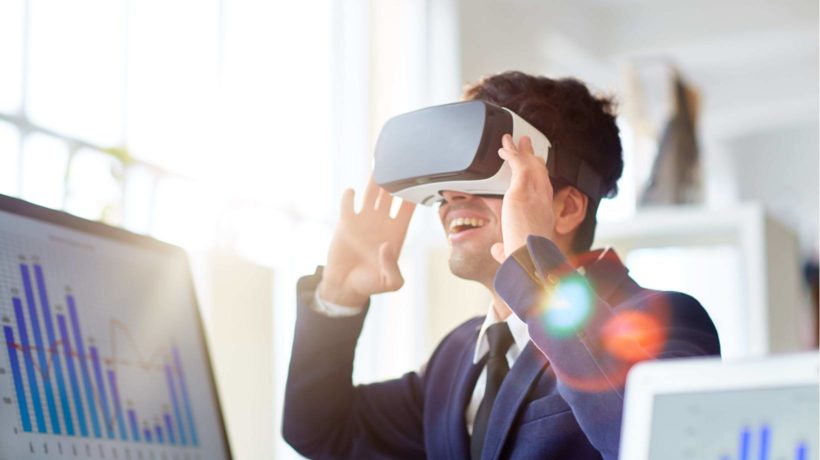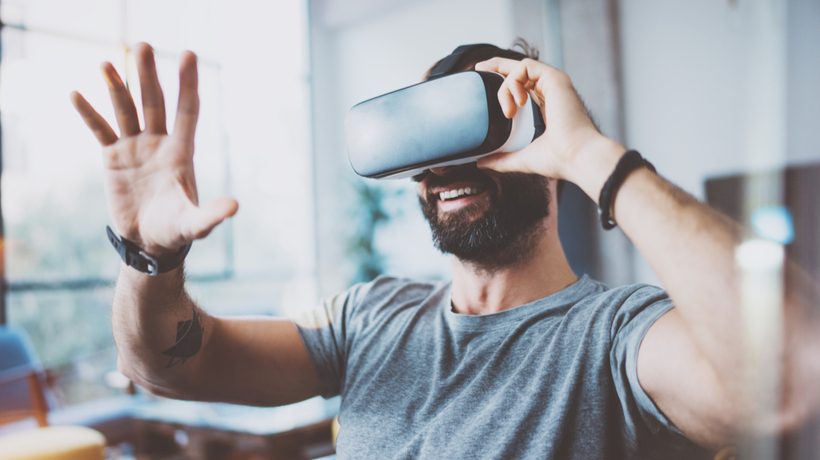With Virtual Training Your Blended Program Will Go Above And Beyond
Many of the world’s top industry players are competing to establish themselves in the Virtual Reality market for media, entertainment, and gaming. For all of us in the L&D community, this is great news. With big players in the mix, you can anticipate the VR market will grow, change, and become commoditized. And, as designers and developers of VR training, we can watch the VR trends happening in entertainment and envision how these trends can be applied to learning programs.

In this article, we’ll focus on some of the most promising new developments in VR for learning—some we are already applying and some in the early stages of development—that will be available in the near future. These include multi-learner experiences and Instructor-Led learning, facial and voice recognition, body tracking, and biometric feedback. We’ll also talk about how these trends could be applied in blended learning programs.
Multi-Learner Experiences And Instructor-Led Learning
Organizations are using VR for more than just training: Collaboration, design, and virtual meetings can all happen in VR. Multi-learner experiences are a natural evolution of collaboration tools and virtual meetings. When you can’t be in the same room with someone, VR can be the next best thing, and in some ways even better.
The SweetRush team has developed the exciting technology to enable multi-learner experiences in which learners in VR headsets (located around the globe!) can meet in the “Tree Island” space.
“Tree Island” is a virtual studio that teaches learning professionals about VR technology. The experience is part of the company’s XR Workshop that helps L&D pros gain experience with stakeholder buy-in for VR learning programs.
Enabling two or more learners to meet in VR and learn together brings the experience of a group activity in a live classroom to the virtual world. The possibilities for activities are limitless: Learners can work together to solve challenges, identify risks, and perform tasks. These learners may be miles away in real life while working and learning together in real time—providing a version of human connection our distributed workforce is craving these days.
Instructor-Led VR training helps us evolve from in-person training to virtual learning by providing instructors with control over the learning experience. Instructors can “join” learners in the VR space, observe them performing tasks, and provide real-time guidance and feedback.
Additionally, instructors can actually control the VR environment and trigger changes that learners will need to react and respond to! This is real-time adaptive learning—instructors can observe how learners are performing in the learning environment and control how and what new challenges are introduced.
Facial Recognition
How a person “looks” when they’re communicating with others tells a lot about their internal emotional state. Are they smiling when they interact with a customer? Does a business leader look uninterested when communicating a change strategy to his or her team? These facial expressions demonstrate the level of interest and specific emotion a person has when interacting in the real world.
Another trend in early stages of development is facial recognition in VR training. With this technology, we’ll be able to capture and use this data in real time within the learning experience. This could be as simple as providing feedback to the learner based on facial expressions, or as complex as triggering a specific reaction from an avatar or actor in the program, or from an outside instructor who is observing.
This data can also be analyzed after the learning experience. L&D professionals can look for common responses in a learner population and determine if further training or reinforcement is needed for specific situations.
Voice Recognition and Analysis
Through built-in microphones in headsets, we can also capture data on speech and vocal tone. Again, this can be used in real time to provide feedback or trigger actions within the learning experience.
This technology was a key part of a VR training solution we created for health care workers on de-escalating aggressive behavior. As we learned from the Subject Matter Experts, how you speak (your tone) is just as important as what you say. Vocal tone is tracked and evaluated, and learners are provided with actionable feedback.
This VR learning program teaches healthcare professionals and security personnel in hospitals how to deescalate aggressive behavior. Learners speak their choice, and the program analyzes their voice and tone, then provides direct and immediate feedback.
Body Movement Tracking
Making learning scalable means taking away the need for one-to-one observation. When learning objectives are tied to physical movement, VR is a great solution to assess if someone is performing a physical movement in the correct way without needing a human observer. Whatever you need to track—upper or lower body—it’s all possible. How you track will depend on what body movements you need to assess and the capabilities of your hardware.
For most VR training programs, cameras in the headset or outside the headset are sufficient to track general body position. We can assess where the learners are standing and where they move throughout. For more sophisticated body movement assessment, the learner can also wear external sensors (similar to those used when doing motion capture) on any part of the body, which will capture and send data to the VR program.
The applications of this are wider than you might think. What likely comes to mind is technical training on proper movements for lifting heavy objects or using equipment.
We recently used body tracking to great effect as a critical component in a VR training program we created. VR tracks and assesses if the learner is in the correct position to minimize the risk of harm and provides feedback to the learner in real time. To learn more about this program, check out the webinar recording, VR Training Program Case Study: Aggressive Behavior De-Escalation at a Health Care Sector Organization.
Biometric Feedback
An exciting evolution for VR—and one we’ve developed at SweetRush—is the potential for integration of biometric feedback. Using Internet of Things (IoT) technology, programmers can connect the VR hardware with wearable devices, allowing them to send and receive data to enhance the learning experience.
Which data depends entirely on what the wearable can track: heart rate, heart rate variability, resting heart rate, body temperature, blood pressure, VO2 max, steps, brain activity, etc. And in the near future, it may all be tracked using the VR hardware. The LooxidVR system, which could be used in virtual-exposure therapy for treating PTSD, includes EEG brainwave sensors [1].
What does this mean for learning? Some examples: We can use the learner’s heart rate to monitor how he or she is dealing with stress in certain situations. We can monitor the level of exertion a person requires to perform a certain task. This data could be presented to the learner in real time, as a constant visual (e.g., a number or visual meter) or as an alert when needed. Presenting this data to learners helps them self-monitor their body’s reaction to what they are experiencing or performing in the VR simulation.
Biometric feedback has incredible potential for learning analytics as well. L&D professionals can review aggregate data about a learning population and identify ways to enhance the VR training (or other aspects of the blended learning program) and/or further training opportunities.
Blended Learning Programs With Virtual Reality
In terms of Learning Experience Design, the technology advances listed above have one thing in common: They will all enhance the ability for learners to practice.
- Multi-learner experiences and Instructor-Led experiences create opportunities for group and guided practice. Learners can practice with peers or have the support of instructors while they are in a safe practice environment.
- Voice and tone, body movement, and biometric feedback tracking all offer opportunities to assess the learner’s actions during practice, provide real-time feedback on those actions, and offer opportunities to retry.
As you’re designing a blended learning program using these technologies, think about what you need before and after the practice in VR to ensure knowledge transfer and retention. For example, consider starting with an eLearning component to teach basic knowledge and concepts. After the VR practice, a group debrief and coaching session in VILT may help reinforce what’s learned through practice.
As always, understanding your audience and desired learning outcomes is essential to creating effective blended learning design.
The Bright Future of VR Training
We’re constantly inspired by the new developments in VR technology being created by the SweetRush SPARK team and the ways in which we are able to leverage them for L&D. Achieving success in VR requires experimentation and innovation—a dedication to and excitement for R&D. And we are indeed excited!
The investment in collaboration technology by head-mounted display (HMD) manufacturers is good news for L&D, particularly as COVID-19 creates increased demand for innovative virtual training solutions. This means that there will be more support for VR training than ever before, driving innovation in the technology and increasing ROI for the business.
If you’re interested in how VR can integrate seamlessly into your blended learning program and L&D strategy, download Your Guide to VR Training Programs: Virtual Reality for Our New Reality. In this comprehensive guide, you’ll discover how to identify programs that can benefit from VR, gain buy-in, and apply best practices for Instructional Design. You can also join the webinar VR Training Program Case Study to learn all you need to know through a success story!
References:
[1] Adding Biometrics to Virtual Reality to Gauge How You’re Really Feeling








